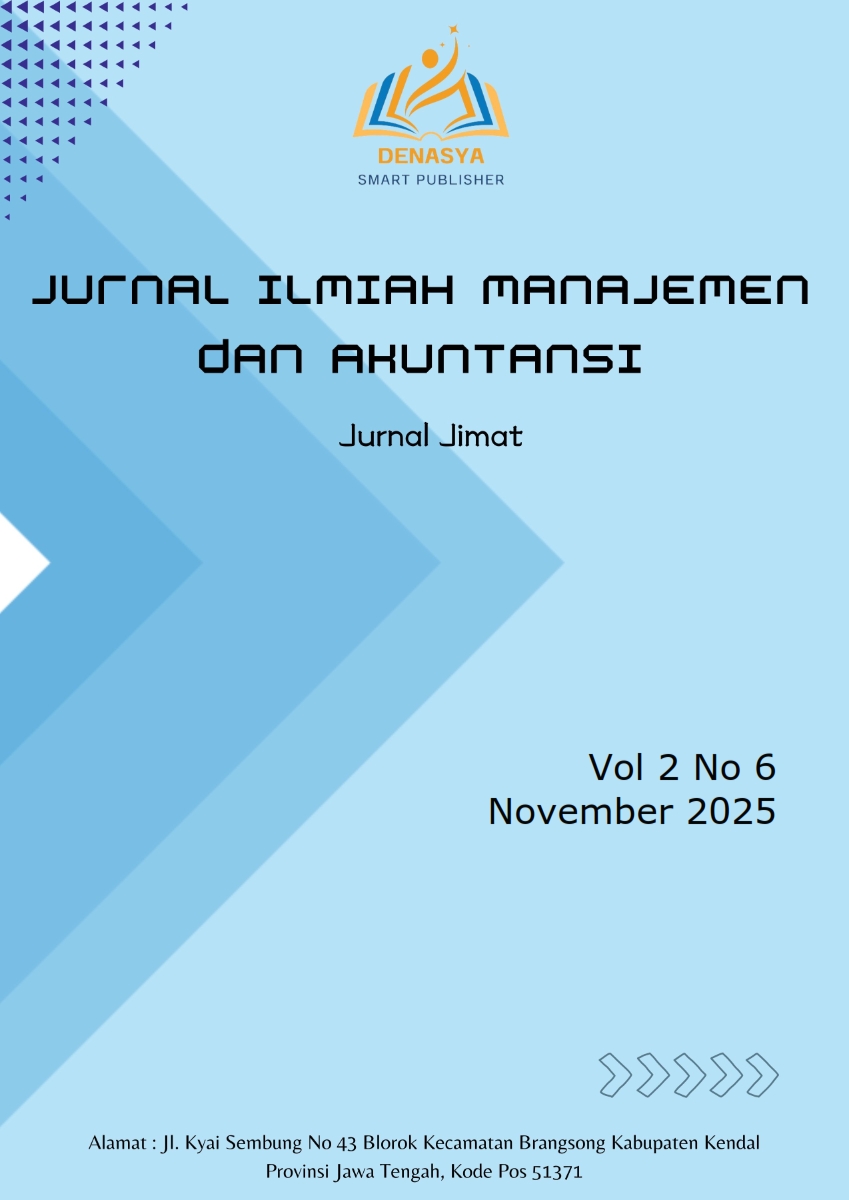PENGARUH PROFITABILITAS, UKURAN PERUSAHAAN, DAN CAPITAL INTENSITY, TERHADAP PENGHINDARAN PAJAK PADA MANUFAKTUR SUB SEKTOR MAKANAN DAN MINUMAN YANG TERDAFTAR DI BURSA EFEK INDONESIA TAHUN 2023-2024
DOI:
https://doi.org/10.69714/37yr2z56Keywords:
Profitability, Firm Size , Capital Intensity, and Tax AvoidanceAbstract
In managing a company's tax burden, there are several actions that can be taken, one of which is commonly implemented by companies—tax avoidance. This study aims to analyze the influence of profitability, firm size, and capital intensity on tax avoidance. The research includes two variables: independent and dependent variables. The dependent variable is tax avoidance, which is measured using the Cash Effective Tax Rate (CETR) proxy. Meanwhile, the independent variables in this study are profitability, measured by Return on Assets (ROA); capital intensity, measured by the Capital Intensity Ratio (CIR); and firm size, which is measured using the natural logarithm of total assets. This study adopts a quantitative approach and uses purposive sampling to obtain the sample. The sample consists of 20 companies over a two-year period, resulting in a total of 40 data observations from companies listed on the Indonesia Stock Exchange (IDX) for the years 2023–2024. The analytical technique employed in this research is multiple linear regression, and the data is processed using SPSS software version 22. The results of the study indicate that profitability, capital intensity, and firm size have a significant influence on tax avoidance.
References
Adisamantha, I.B.P.F., dan Noviari, N. (2019). Pengaruh Intensitas Modal, Intensitas Modal, Intensitass Persediaan Dan Aset Tetap Pada Tingkat Agresivitas Wajib Pajak Badan. E-Jurnal akuntansi universitas udayana. Vol.13, No.3, hal 977-978, 980, 994-995.
Agnes Sawir, 2009. Analisa Kinerja Keuangan dan Perencanaan Keuangan Perusahaan, Jakarta: PT. Gramedia Pustaka Utama.
Agus Sartono, 2012. Manajemen Keuangan Teori dan Aplikasi. Yogyakarta. BPFE.
Bambang Riyanto, 2010. Dasar-dasar Pembelanjaan Perusahaan. Yogyakarta. BPFE.
Budianti, Shinta., dan Curry, Khristina., 2018. Pengaruh Profitabilitas, Intensitas Modal, dan Capital Intensity Terhadap Penghidaran Pajak (tax avoidance). jurnal Ekonomi.
Budiman, Judi dan Setiyono. 2012. Pengaruh Karakter Eksekutif Terhadap Penghindaran Pajak (tax avoidance). Symposium Nasional Akuntansi.
Chen, Shuping, Xia Chen, Qiang Cheng. 2010. Are Family Firms more tax aggressive than non-family firms. Journal of Financial Economics Hal.41- 61
Damayanti, 2019. Pengaruh Komite Audit, Kualitas Audit, Kepemilikan Institusional, Return On Assets Terhadap Tax Avoidance, Jurnal Bisnis dan Manajemen, Vol.5, No.2, 187-206
Dendawijaya, Lukman. 2009. Manajemen Perbankan. Jakarta: Ghalia Indonesia
Dwi Martani, Sylvia Veronica NPS, Ratna Wardhani, Aria Farahmita, dan Edward Tanujaya. 2012. Akuntansi Keuangan Menengah Berbasis PSAK. Jakarta: Salemba Empat.
Fahmi, Irham, 2019. Pengantar Manajemen Keuangan Teori dan Soal Jawab. Bandung: Alfabeta
Ghozali, Imam, (2017). Aplikasi Analisis Multivariat dengan Program SPSS, Edisi 7, Semarang. Badan Penertbit Universitas Diponegoro.
Harahap, Sofyan Syafri. 2012. Teori Akuntansi Edisi Revisi 2011. Jakarta: Rajawali.
Hery, 2020. Analisis Laporan Keuangan. Jakrta: Grasindo.
Hidayat, M., & Ramadhani, L. (2023). Firm Size, Leverage, and Tax Planning: An Empirical Study in Indonesia. International Journal of Accounting and Finance Research, 11(1), 55–67. https://doi.org/10.5430/ijafr.v11n1p55
Putri, A., & Kurniawan, R. (2022). The Effect of Corporate Governance on Tax Avoidance: Evidence from Emerging Markets. Jurnal Akuntansi dan Keuangan Indonesia, 19(2), 145–160. https://doi.org/10.21002/jaki.v19i2.1234
Downloads
Published
Issue
Section
License
Copyright (c) 2025 Jurnal Ilmiah Manajemen dan Akuntansi

This work is licensed under a Creative Commons Attribution-ShareAlike 4.0 International License.
















